A Planar Ultrawideband Patch Antenna Array for Microwave Breast Tumor Detection
Abstract
1. Introduction
2. Design Methodology of the Proposed Antenna
3. Parametric Study of the Proposed Antenna
4. Result and Discussion
4.1. Performance Analysis in the Frequency Domain
4.2. Performance Analysis in the Time Domain
5. Imaging Setup and Result Discussion
6. Conclusions
Author Contributions
Funding
Acknowledgments
Conflicts of Interest
References
- Islam, M.; Mahmud, M.; Islam, M.T.; Kibria, S.; Samsuzzaman, M. A low cost and portable microwave imaging system for breast tumor detection using UWB directional antenna array. Sci. Rep. 2019, 9, 1–13. [Google Scholar] [CrossRef] [PubMed]
- Islami, F.; Torre, L.A.; Drope, J.M.; Ward, E.; Jemal, A. Global cancer in women: Cancer control priorities. Cancer Epidemiol. Biomarkers Prev. 2017, 26, 458–470. [Google Scholar] [CrossRef] [PubMed]
- Zhang, H. Microwave Imaging for Ultra-Wideband Antenna Based Cancer Detection. Ph.D. Thesis, The University of Edinburgh, Edinburgh, UK, July 2015. [Google Scholar]
- Mahmud, M.Z.; Islam, M.T.; Misran, N.; Kibria, S.; Samsuzzaman, M. Microwave imaging for breast tumor detection using uniplanar AMC based CPW-fed microstrip antenna. IEEE Access 2018, 6, 44763–44775. [Google Scholar] [CrossRef]
- O’Loughlin, D.; O’Halloran, M.; Moloney, B.M.; Glavin, M.; Jones, E.; Elahi, M.A. Microwave breast imaging: Clinical advances and remaining challenges. IEEE Trans. Biomed. Eng. 2018, 65, 2580–2590. [Google Scholar] [CrossRef] [PubMed]
- Mettler Jr, F.A.; Wiest, P.W.; Locken, J.A.; Kelsey, C.A. CT scanning: Patterns of use and dose. J. Radiol. Prot. 2000, 20, 353. [Google Scholar] [CrossRef]
- Nikolova, N.K. Microwave imaging for breast cancer. IEEE Microw. Mag. 2011, 12, 78–94. [Google Scholar] [CrossRef]
- Jacobs, M.A.; Ibrahim, T.S.; Ouwerkerk, R. MR imaging: Brief overview and emerging applications. Radiographics 2007, 27, 1213–1229. [Google Scholar] [CrossRef]
- Baltzer, P.A.; Benndorf, M.; Dietzel, M.; Gajda, M.; Runnebaum, I.B.; Kaiser, W.A. False-positive findings at contrast-enhanced breast MRI: A BI-RADS descriptor study. AJR Am. J. Roentgenol. 2010, 194, 1658–1663. [Google Scholar] [CrossRef]
- Narouze, S.N. Atlas of Ultrasound-Guided Procedures in Interventional Pain Management; Springer: New York, NY, USA, 2018. [Google Scholar]
- Lim, H.B.; Nhung, N.T.T.; Li, E.-P.; Thang, N.D. Confocal microwave imaging for breast cancer detection: Delay-multiply-and-sum image reconstruction algorithm. IEEE Trans. Biomed. Eng. 2008, 55, 1697–1704. [Google Scholar] [PubMed]
- Conceição, R.C.; Mohr, J.J.; O’Halloran, M. An Introduction to Microwave Imaging for Breast Cancer Detection; Springer: New York, NY, USA, 2016. [Google Scholar]
- Islam, M.T.; Samsuzzaman, M.; Faruque, M.; Singh, M.J.; Islam, M. Microwave imaging based breast tumor detection using compact wide slotted UWB patch antenna. Optoelectron. Adv. Mater. Rapid Commun. 2019, 13, 448–457. [Google Scholar]
- Kibria, S.; Samsuzzaman, M.; Islam, M.T.; Mahmud, M.Z.; Misran, N.; Islam, M.T. Breast phantom imaging using iteratively corrected coherence factor delay and sum. IEEE Access 2019, 7, 40822–40832. [Google Scholar] [CrossRef]
- Halili, K.; Ojaroudi, M.; Ojaroudi, N. Ultrawideband monopole antenna for use in a circular cylindrical microwave imaging system. Microw. Opt. Technol. Lett. 2012, 54, 2202–2205. [Google Scholar] [CrossRef]
- Sugitani, T.; Kubota, S.; Toya, A.; Xiao, X.; Kikkawa, T. A compact 4 x 4 planar UWB antenna array for 3-D breast cancer detection. IEEE Antennas Wirel. Propag. Lett. 2013, 12, 733–736. [Google Scholar] [CrossRef]
- Suh, S.-Y.; Stutzman, W.L.; Davis, W.A. A new ultrawideband printed monopole antenna: The planar inverted cone antenna (PICA). IEEE Trans. Antennas Propag. 2004, 52, 1361–1364. [Google Scholar] [CrossRef]
- Powell, J.; Chandrakasan, A. Spiral slot patch antenna and circular disc monopole antenna for 3.1–10.6 GHz ultra wideband communication. ISAP 2004 2004, 8, 1–10. [Google Scholar]
- Paulsen, L.; West, J.; Perger, W.; Kraus, J. Recent investigations on the volcano smoke antenna. In Proceedings of the IEEE Antennas and Propagation Society International Symposium. Digest. Held in conjunction with: USNC/CNC/URSI North American Radio Sci. Meeting (Cat. No. 03CH37450), Columbus, OH, USA, 22–27 June 2003; pp. 845–848. [Google Scholar]
- Hossain, A.; Islam, M.T.; Almutairi, A.F.; Singh, M.S.J.; Mat, K.; Samsuzzaman, M. An octagonal ring-shaped parasitic resonator based compact ultrawideband antenna for microwave imaging applications. Sensors 2020, 20, 1354. [Google Scholar] [CrossRef]
- Mahmud, M.Z.; Islam, M.T.; Almutairi, A.F.; Samsuzzaman, M.; Acharjee, U.; Islam, M.T. A parasitic resonator-based diamond-shaped microstrip antenna for microwave imaging applications. Electronics 2019, 8, 434. [Google Scholar] [CrossRef]
- Mewara, H.S.; Deegwal, J.K.; Sharma, M.M. A slot resonators based quintuple band-notched Y-shaped planar monopole ultra-wideband antenna. Aeu-Int. J. Electron C. 2018, 83, 470–478. [Google Scholar] [CrossRef]
- Ojaroudi, M.; Civi, O.A. Bandwidth enhancement of small square monopole antenna using self-complementary structure for microwave imaging system applications. Appl. Comput. Electromagn. Soc. J. 2015, 30, 1360–1365. [Google Scholar]
- Li, T.; Zhai, H.; Li, L.; Liang, C.; Han, Y. Compact UWB antenna with tunable band-notched characteristic based on microstrip open-loop resonator. IEEE Antennas Wirel. Propag. Lett. 2012, 11, 1584–1587. [Google Scholar] [CrossRef]
- Borja, B.; Tirado, J.A.; Jardon, H. An overview of UWB antennas for microwave imaging systems for cancer detection purposes. Prog. Electromagn. Res. B 2018, 80, 173–198. [Google Scholar] [CrossRef][Green Version]
- Hasim, N.S.B.; Ping, K.A.H.; Islam, M.T.; Mahmud, M.Z.; Sahrani, S.; Mat, D.A.A.; Zaidel, D.N.A. A slotted UWB antipodal vivaldi antenna for microwave imaging applications. Prog. Electromagn. Res. 2019, 80, 35–43. [Google Scholar] [CrossRef]
- Islam, M.T.; Samsuzzaman, M.; Islam, M.; Kibria, S.; Singh, M.J. A homogeneous breast phantom measurement system with an improved modified microwave imaging antenna sensor. Sensors 2018, 18, 2962. [Google Scholar] [CrossRef] [PubMed]
- Natarajan, R.; George, J.V.; Kanagasabai, M.; Shrivastav, A.K. A compact antipodal Vivaldi antenna for UWB applications. IEEE Antennas Wirel. Propag. Lett. 2015, 14, 1557–1560. [Google Scholar] [CrossRef]
- Salleh, A.; Yang, C.C.; Alam, T.; Singh, M.S.J.; Samsuzzaman, M.; Islam, M.T. Development of microwave brain stroke imaging system using multiple antipodal vivaldi antennas based on raspberry Pi technology. J. Kejuruterran 2020, 32, 1–6. [Google Scholar]
- Samsuzzaman, M.; Islam, M.T.; Islam, M.T.; Shovon, A.A.; Faruque, R.I.; Misran, N. A 16-modified antipodal Vivaldi antenna array for microwave-based breast tumor imaging applications. Microw. Opt. Technol. Lett. 2019, 61, 2110–2118. [Google Scholar] [CrossRef]
- Selvaraj, V.; Srinivasan, P.; Kumar, J.; Krishnan, R.; Annamalai, K. Highly directional microstrip ultra wide band antenna for microwave imaging system. Acta Graphica: Znanstveni Časopis za Tiskarstvo i Grafičke Komunikacije 2017, 28, 35–40. [Google Scholar]
- Islam, M.T.; Mahmud, M.Z.; Misran, N.; Takada, J.-I.; Cho, M. Microwave breast phantom measurement system with compact side slotted directional antenna. IEEE Access 2017, 5, 5321–5330. [Google Scholar] [CrossRef]
- Mahmud, M.; Islam, M.T.; Misran, N.; Almutairi, A.F.; Cho, M. Ultra-wideband (UWB) antenna sensor based microwave breast imaging: A review. Sensors 2018, 18, 2951. [Google Scholar] [CrossRef]
- Porter, E.; Bahrami, H.; Santorelli, A.; Gosselin, B.; Rusch, L.A.; Popović, M. A wearable microwave antenna array for time-domain breast tumor screening. IEEE Trans. Med. Imaging 2016, 35, 1501–1509. [Google Scholar] [CrossRef]
- Saeidi, T.; Ismail, I.; Wen, W.P.; Alhawari, A.R. Ultra-wideband elliptical patch antenna for microwave imaging of wood. Int. J. Microw. Wirel. Trans. 2019, 11, 948–966. [Google Scholar] [CrossRef]
- Islam, M.; Islam, M.T.; Faruque, M.R.I.; Samsuzzaman, M.; Misran, N.; Arshad, H. Microwave imaging sensor using compact metamaterial UWB antenna with a high correlation factor. Materials 2015, 8, 4631–4651. [Google Scholar] [CrossRef] [PubMed]
- Azim, R.; Islam, M.T.; Misran, N. Compact tapered-shape slot antenna for UWB applications. IEEE Antennas Wirel. Propag. Lett. 2011, 10, 1190–1193. [Google Scholar] [CrossRef]
- Islam, M.T.; Samsuzzaman, M.; Islam, M.T.; Kibria, S. Experimental breast phantom imaging with metamaterial-inspired nine-antenna sensor array. Sensors 2018, 18, 4427. [Google Scholar] [CrossRef] [PubMed]
- Jafari, H.; Deen, J.; Hranilovic, S.; Nikolova, N. Co-polarised and cross-polarised antenna arrays for breast, cancer detection. IET Microw. Antennas Propag. 2007, 1, 1055–1058. [Google Scholar] [CrossRef]
- Porter, E.; Kirshin, E.; Santorelli, A.; Coates, M.; Popović, M. Time-domain multistatic radar system for microwave breast screening. IEEE Antennas Wirel. Propag. Lett. 2013, 12, 229–232. [Google Scholar] [CrossRef]
- Islam, M.T.; Samsuzzaman, M.; Rahman, M.; Islam, M.T. A compact slotted patch antenna for breast tumor detection. Microw. Opt. Technol. Lett. 2018, 60, 1600–1608. [Google Scholar] [CrossRef]
- Quintero, G.; Zurcher, J.-F.; Skrivervik, A.K. System fidelity factor: A new method for comparing UWB antennas. IEEE Antennas Wirel. Propag. Lett. 2011, 59, 2502–2512. [Google Scholar]
- Lazebnik, M.; Popovic, D.; McCartney, L.; Watkins, C.B.; Lindstrom, M.J.; Harter, J.; Sewall, S.; Ogilvie, T.; Magliocco, A.; Breslin, T.M. A large-scale study of the ultrawideband microwave dielectric properties of normal, benign and malignant breast tissues obtained from cancer surgeries. Phys. Med. Biol. 2007, 52, 6093–6115. [Google Scholar] [CrossRef]
- Lazebnik, M.; McCartney, L.; Popovic, D.; Watkins, C.B.; Lindstrom, M.J.; Harter, J.; Sewall, S.; Magliocco, A.; Booske, J.H.; Okoniewski, M. A large-scale study of the ultrawideband microwave dielectric properties of normal breast tissue obtained from reduction surgeries. Phys. Med. Biol. 2007, 52, 2637–2656. [Google Scholar] [CrossRef]
- K Amineh, R.; Trehan, A.; Nikolova, N.K. TEM horn antenna for ultra-wide band microwave breast imaging. Prog. Electromagn. Res. 2009, 13, 59–74. [Google Scholar] [CrossRef]



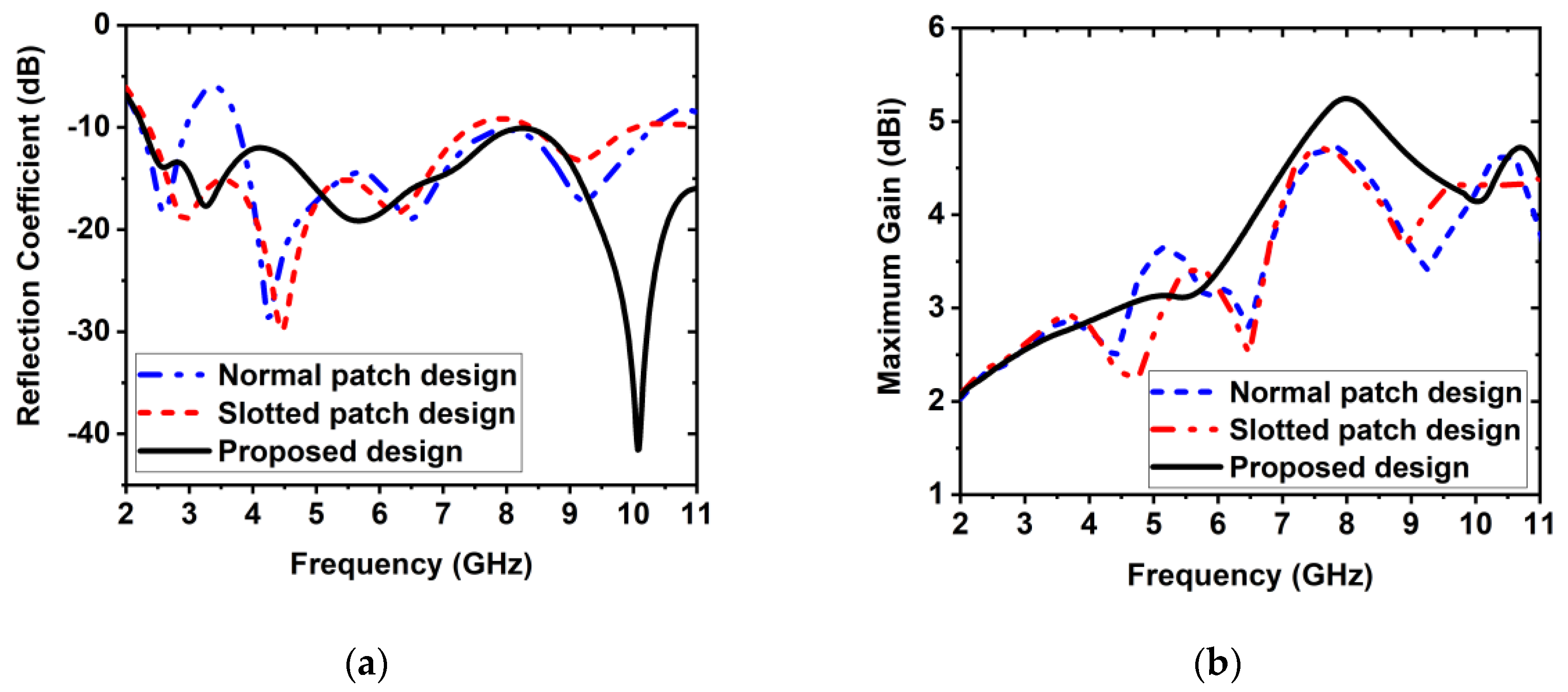
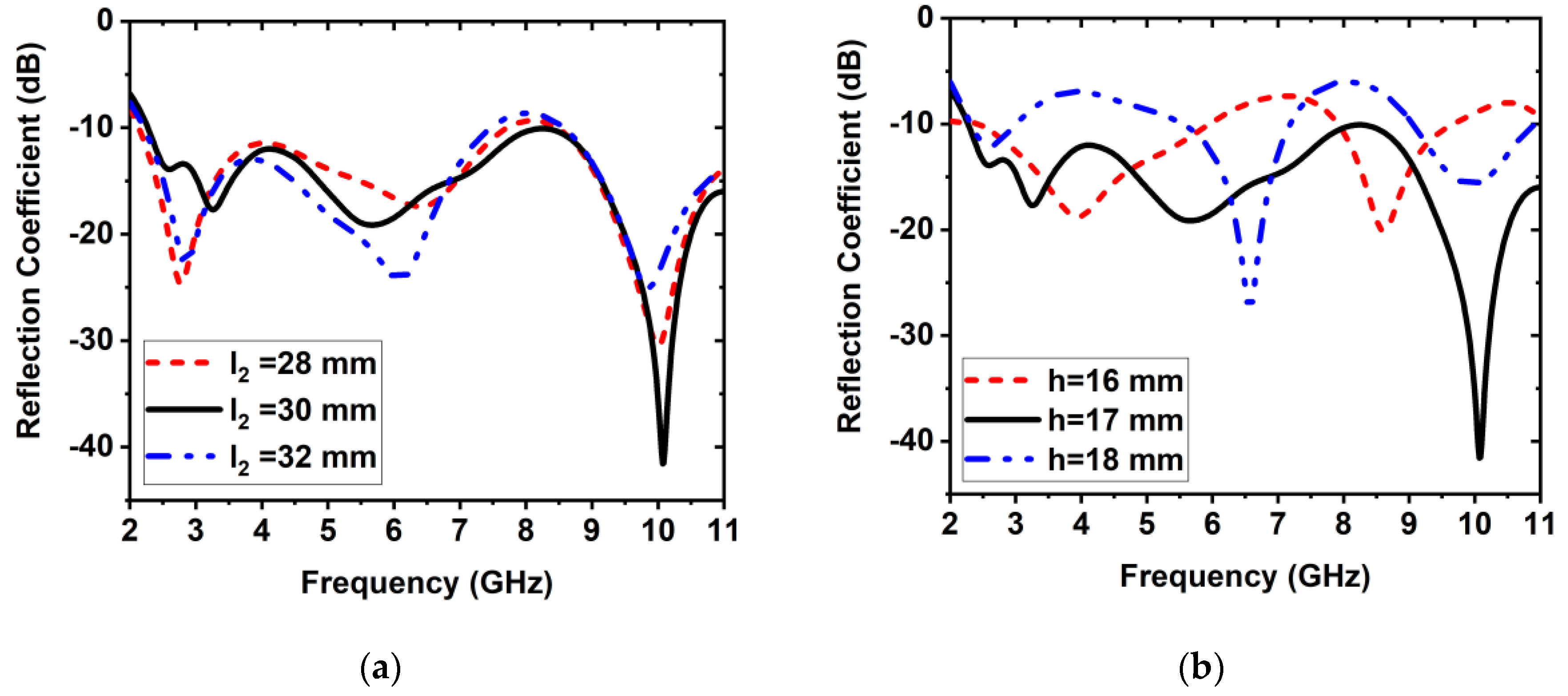


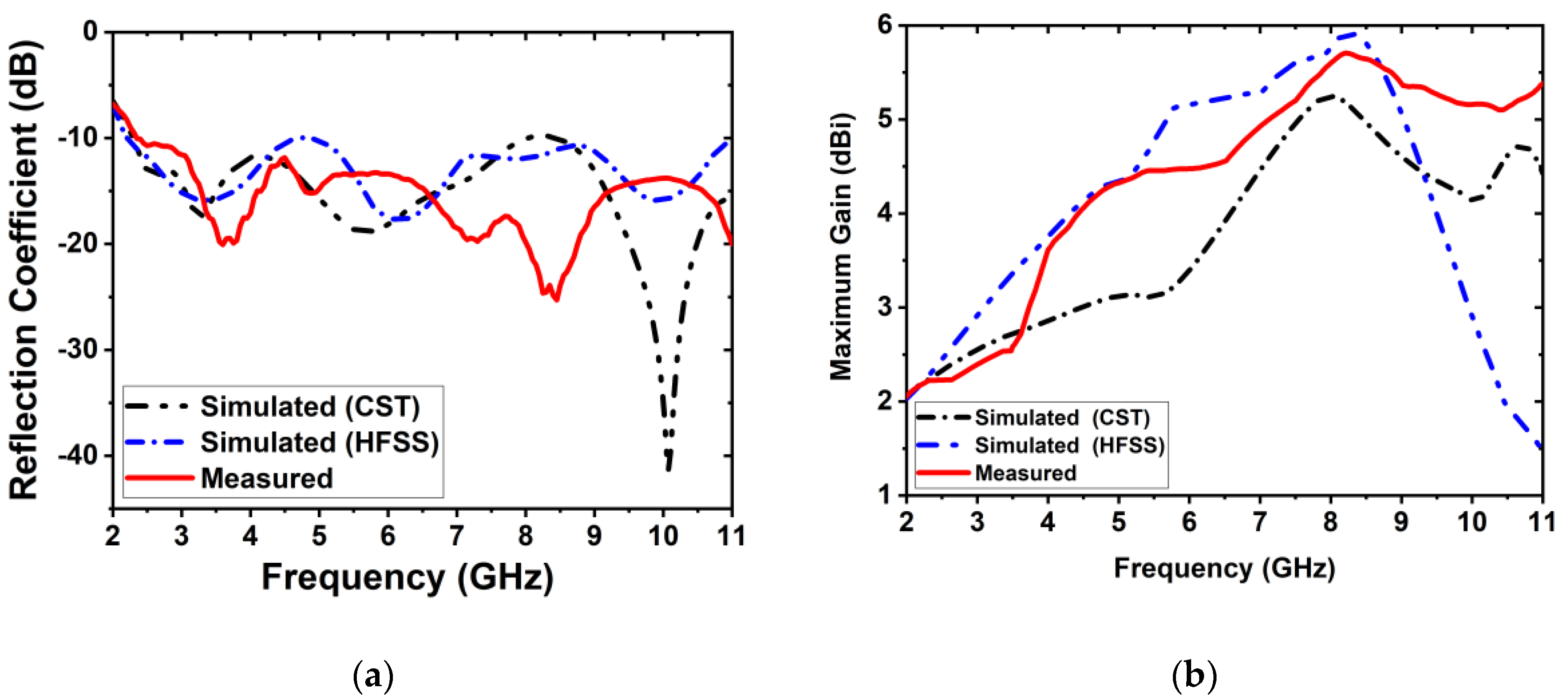
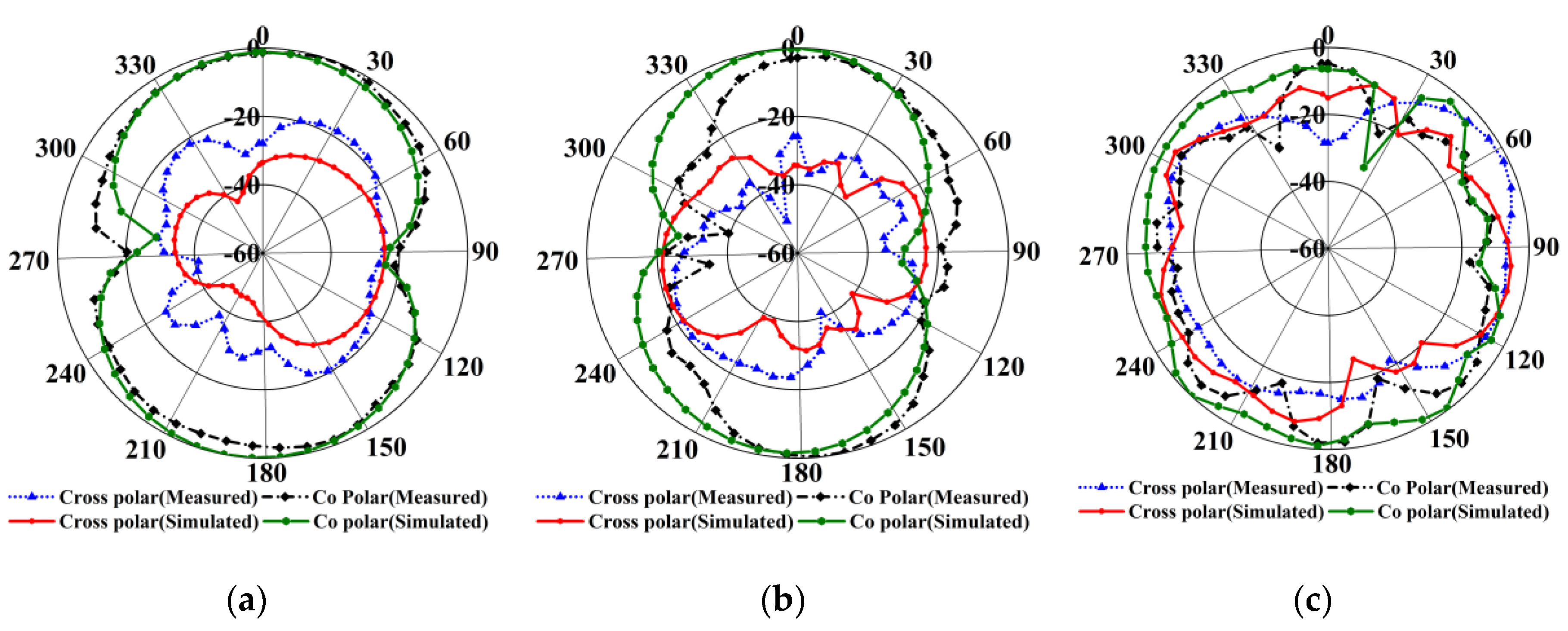
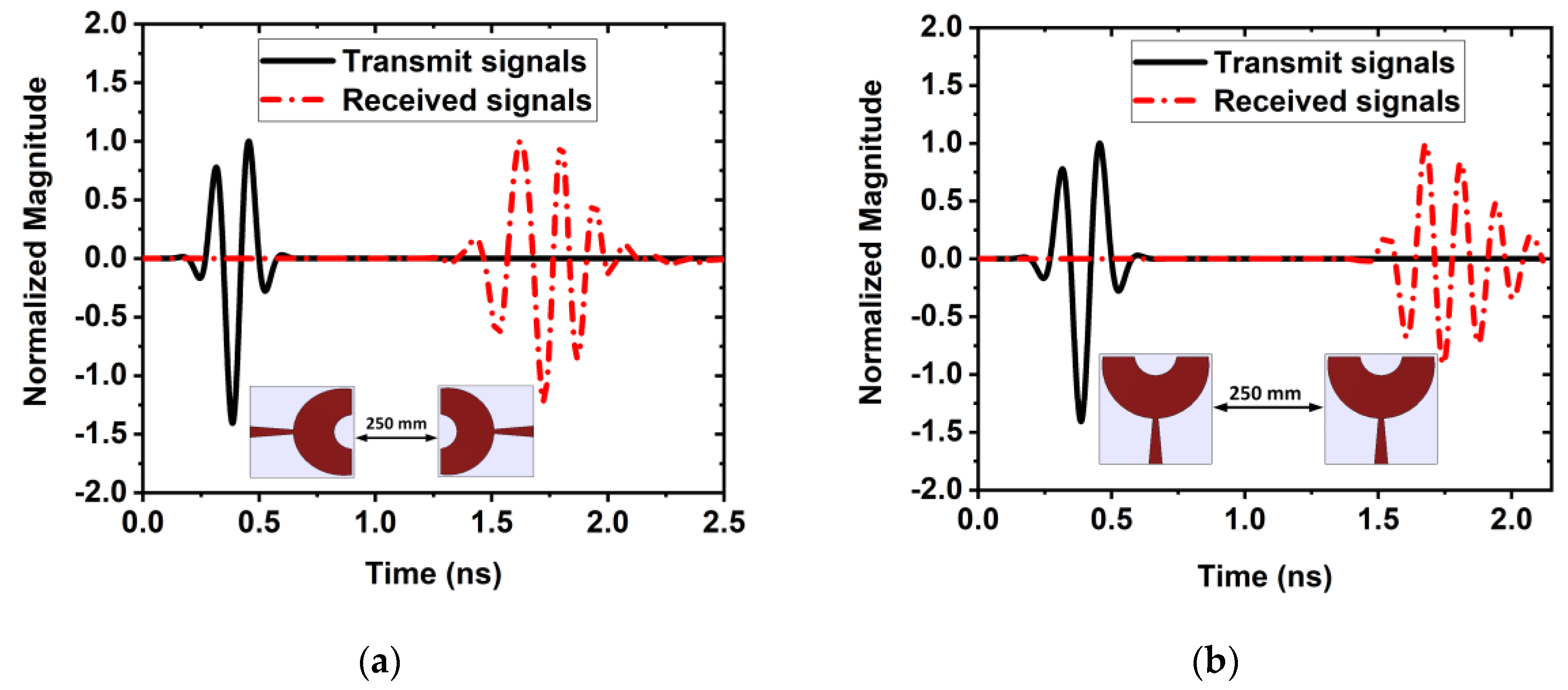

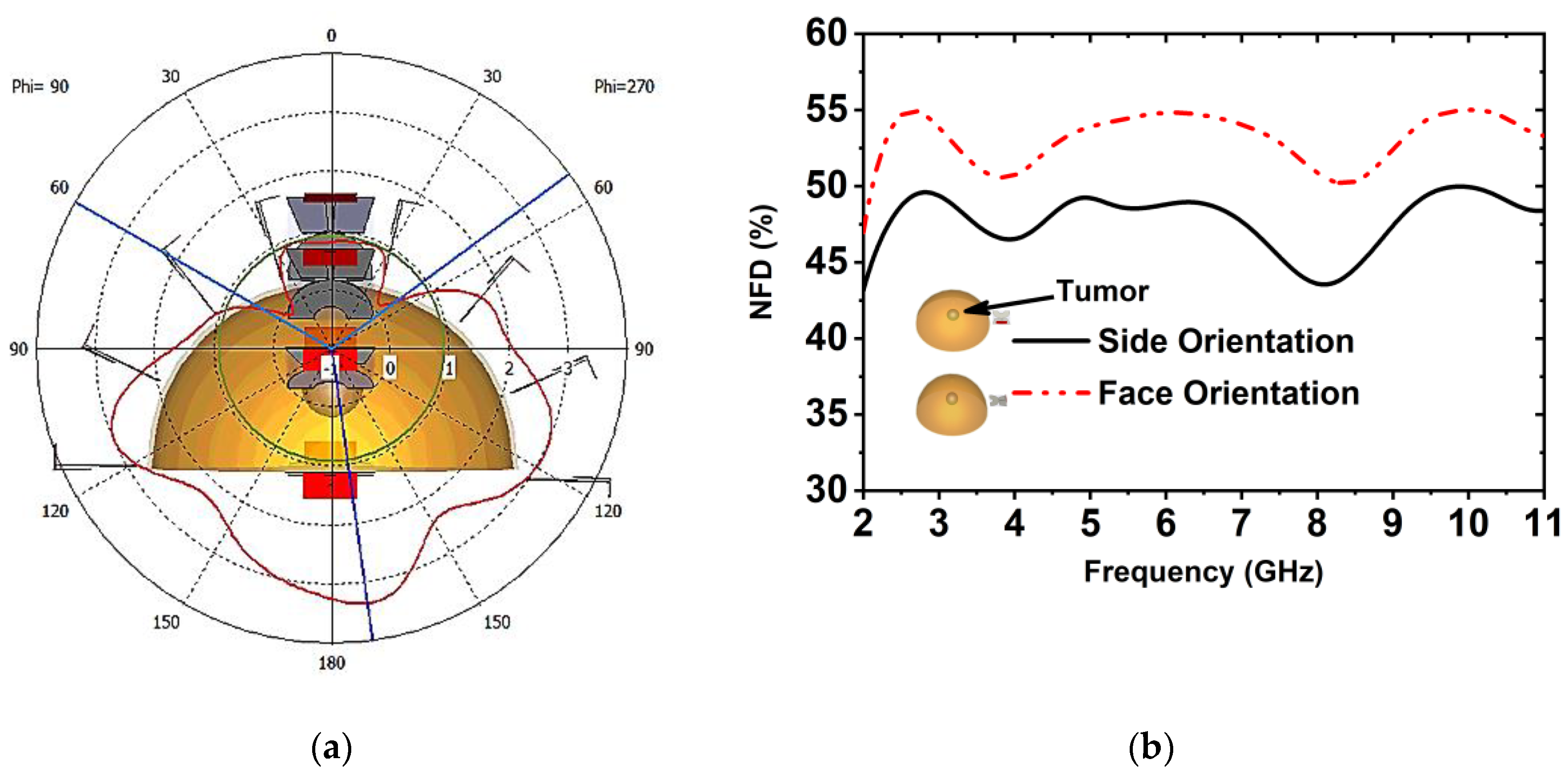
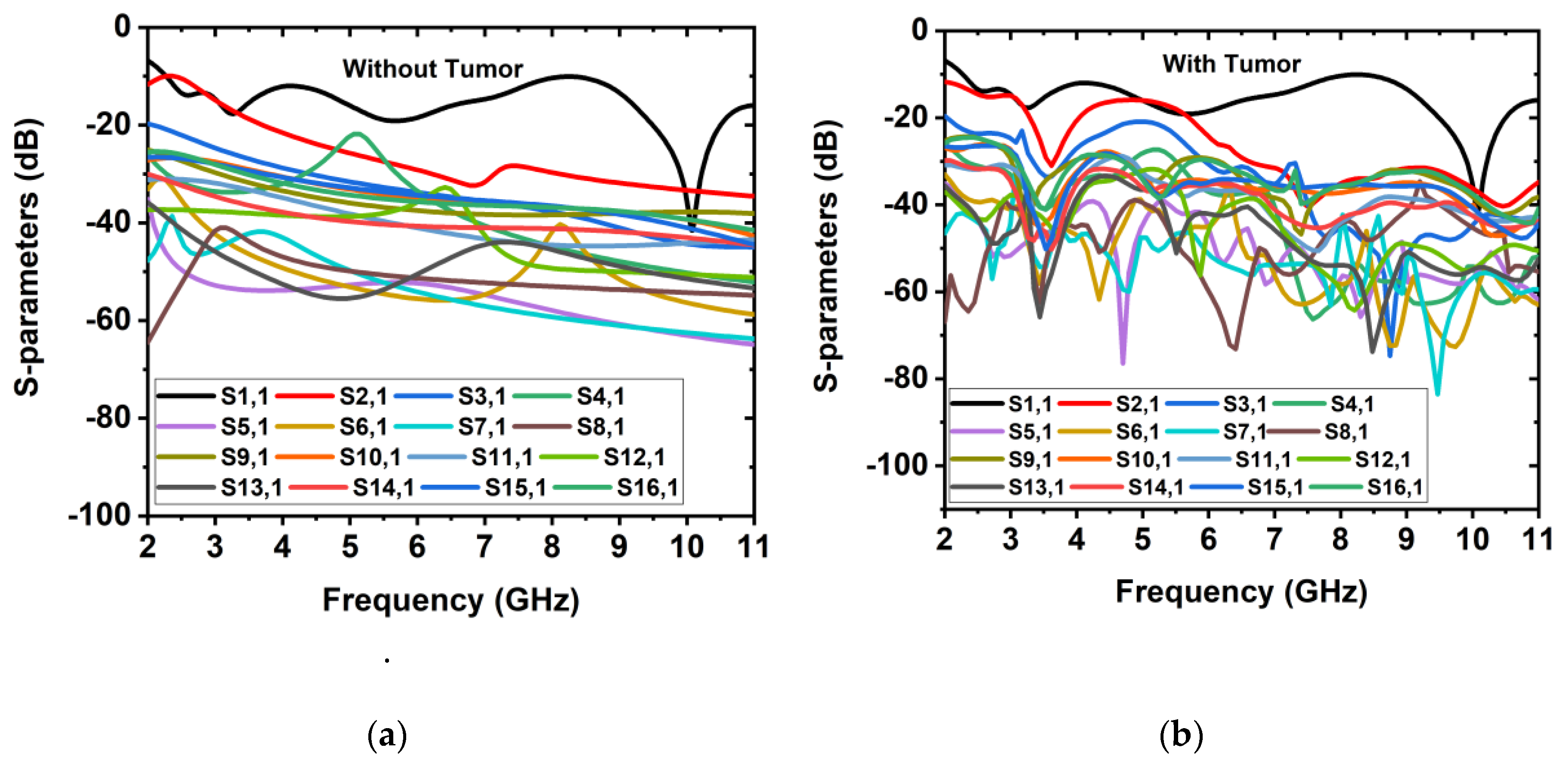
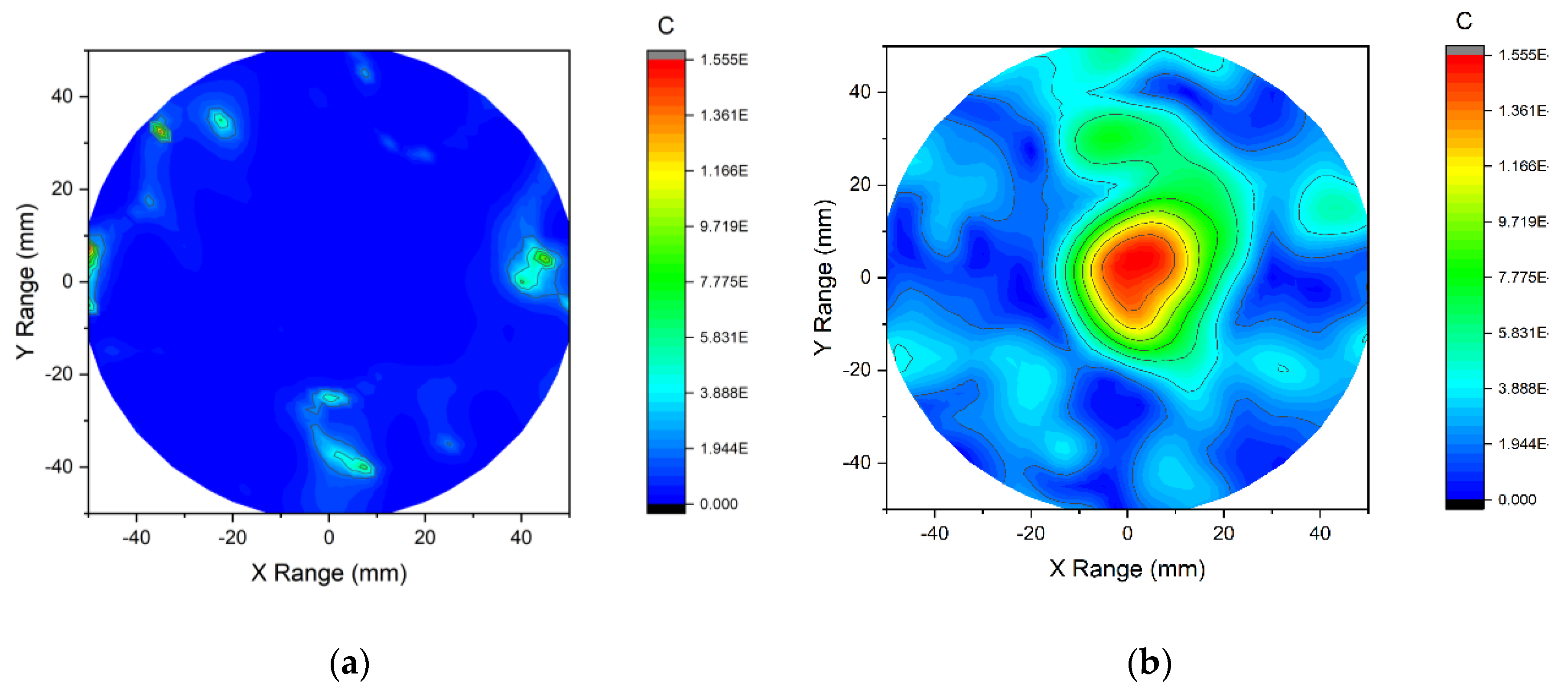
| Parameters | Size (mm) | Parameters | Size (mm) |
|---|---|---|---|
| Sw | 42 | l1 | 17.72 |
| SL | 41 | l2 | 30 |
| d1 | 40 | l3 | 18.38 |
| d2 | 15 | l4 | 42 |
| Lf | 17 | h | 17 |
| Wf | 5 |
| Different Structure Designs | Operating Band (GHz) | Bandwidth (GHz) | Gain (dBi) |
|---|---|---|---|
| Normal patch design | 2.26–3.00 | 0.74 | 2.50 |
| Slotted patch design | 2.30–7.00 | 4.70 | 4.50 |
| Proposed design | 2.26–11.00 | 8.74 | 5.48 |
| Name of the Tissues | Relative Permittivity ( ) | Conductivity ( ) |
|---|---|---|
| Skin | 39 | 1.5 |
| Fat | 15 | 0.14 |
| Tumor | 57 | 5 |
| Ref. No | Antenna Type | Dimension 1(λ3) | Operating Frequency (GHz) | FBW (%) | Gain (dBi) | Elements /Positions | Frequency/Time Domain | Phantom and Tumor Object | Applications |
|---|---|---|---|---|---|---|---|---|---|
| [17] | Planar inverted cone antenna | 0.26 × 0.27 × 0.002 | 1.00–10.00 | 163.63 | 8.00 | Not available | Frequency domain | Not available | Ultrawide-band |
| [18] | Combinat-ions of Monopole antenna | 0.78 × 0.78 × 0.005 | 3.10–10.60 | 109.48 | 10.00 | Not available | Time domain | Not available | Ultrawide-band |
| [19] | Volcano smoke antenna | Not available | 2.00–15.00 | 152.94 | Not reported | Not available | Frequency domain | Not available | Ultrawide-band |
| [1] | Side slotted Vivaldi antenna | 0.47 × 0.39 × 0.015 | 2.80–7.00 | 85.71 | 6.50 | 9 element antennas array, 8 × 50 scanned position | Frequency and Time domain | Heteroge-nous phantom and 2 tumors object | Microwave breast imaging |
| [4] | CPW feed EBG structure antenna | 0.78 × 0.45 × 0.016 | 3.10–7.60 | 84.11 | 9.50 | 2 element antennas array, 2 × 120 scanned position | Frequency domain | Commercial phantom and one tumor object | Microwave breast imaging |
| [13] | Rectangular slotted patch antenna | 0.25 × 0.27 × 0.018 | 3.49–12.00 | 109.87 | 5.76 | 7 element antennas array scanning | Frequency domain | Simulated phantom and one tumor object | Microwave breast imaging |
| [14] | Antipodal Vivaldi antenna | 0.40 × 0.40 × 0.016 | 2.50–8.00 | 104.76 | 7.20 | 9 element antennas array, 50 × 8 scanned position | Frequency domain | Laboratory based phantom and 2 tumor objects | Microwave breast imaging |
| [16] | Slotted planar patch antenna | 0.51 × 0.61 × 0.018 | 3.50–15.00 | 124.32 | 5.50 | 4 × 4 single element | Frequency domain | Simulated phantom and one tumor object | Microwave breast imaging |
| [27] | Slotted antipodal Vivaldi antenna | 0.33 × 0.33 × 0.013 | 3.01–11.00 | 125.92 | 7.20 | 2 element antennas array, 2 × 50 scanned position | Time domain | Simulated phantom, one tumor object | Microwave breast imaging |
| [30] | antipodal Vivaldi antenna | 0.33 × 0.33 × 0.013 | 2.50–11.00 | 125.92 | 7.20 | 16 element antennas array, 16 × 15 scanned position | Frequency domain and time domain | Simulated phantom, one tumor object | Microwave breast imaging |
| [32] | Side slotted Vivaldi antenna | 0.45 × 0.38 × 0.008 | 1.54–7.00 | 127.86 | 8.50 | 2 element antennas array scanning | Frequency domain | Commercial phantom and one tumor object | Microwave breast imaging |
| [34] | CPW feed monopole antenna | 0.53 × 0.5 × 0.01 | 2.00–4.00 | 66.67 | 5.20 | 16 elements array, 16 × 15 scanned position | Time domain | Simulated phantom, one tumor object | Microwave breast imaging |
| [40] | Tapered and transmiss-ion loaded antenna | 0.33 × 0.27 × 0.016 | 2.00–8.00 | 120.00 | 4.89 | 16 element antennas array, 16 × 15 scanned position | Time domain | Lab based phantom and single tumor object | Microwave breast imaging |
| Pro- posed | Semi-circle shaped planar antenna | 0.30 × 0.31 × 0.011 | 2.30–11.00 | 130.82 | 5.80 | 16 element antennas array, 16 × 15 scanned position | Frequency and time domain | Simulated phantom, one tumor object | Microwave breast imaging |
© 2020 by the authors. Licensee MDPI, Basel, Switzerland. This article is an open access article distributed under the terms and conditions of the Creative Commons Attribution (CC BY) license (http://creativecommons.org/licenses/by/4.0/).
Share and Cite
Hossain, A.; Islam, M.T.; Islam, M.T.; Chowdhury, M.E.H.; Rmili, H.; Samsuzzaman, M. A Planar Ultrawideband Patch Antenna Array for Microwave Breast Tumor Detection. Materials 2020, 13, 4918. https://doi.org/10.3390/ma13214918
Hossain A, Islam MT, Islam MT, Chowdhury MEH, Rmili H, Samsuzzaman M. A Planar Ultrawideband Patch Antenna Array for Microwave Breast Tumor Detection. Materials. 2020; 13(21):4918. https://doi.org/10.3390/ma13214918
Chicago/Turabian StyleHossain, Amran, Mohammad Tariqul Islam, Md. Tarikul Islam, Muhammad E. H. Chowdhury, Hatem Rmili, and Md. Samsuzzaman. 2020. "A Planar Ultrawideband Patch Antenna Array for Microwave Breast Tumor Detection" Materials 13, no. 21: 4918. https://doi.org/10.3390/ma13214918
APA StyleHossain, A., Islam, M. T., Islam, M. T., Chowdhury, M. E. H., Rmili, H., & Samsuzzaman, M. (2020). A Planar Ultrawideband Patch Antenna Array for Microwave Breast Tumor Detection. Materials, 13(21), 4918. https://doi.org/10.3390/ma13214918







